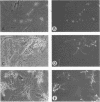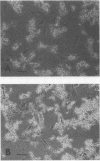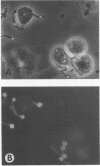Abstract
The interaction of Candida albicans clinical isolates with primary and established fibroblast cultures was studied. The intent was to determine whether yeast adherence and invasion of nonendothelial cell monolayer cultures could be quantitated reproducibly and whether this system could be used for future studies on yeast pathogenesis. Our results demonstrated that specific interactions between the yeast cells and fibroblasts only occurred at 37 degrees C and correlated with the germination process. Fluorescent-antibody staining indicated that invasion or tight associations between the germinating yeast cells and mammalian cells occurred after less than 3 h of incubation. Yeast adherence was estimated radiometrically and trypsin-resistant interaction with individual mammalian cells (infection) was measured microscopically after inoculated monolayer cells were detached with trypsin. We demonstrated that both types of association were time dependent at 37 degrees C; neither was affected by the concentration of glucose used to grow the yeast cells. Primary and established fibroblast cell lines were equally susceptible to infection, but primary cells appeared to have more yeast-binding sites. Fibroblasts maintained in confluent culture for an extended period of time also appeared to have more binding sites, and while not quantitatively more susceptible to infection, the older cells were more susceptible to infection-related cell death. An established kidney epithelial cell line (MDCK) was not susceptible to either type of yeast interaction, indicating that the yeast-fibroblast associations were specific.
Full text
PDF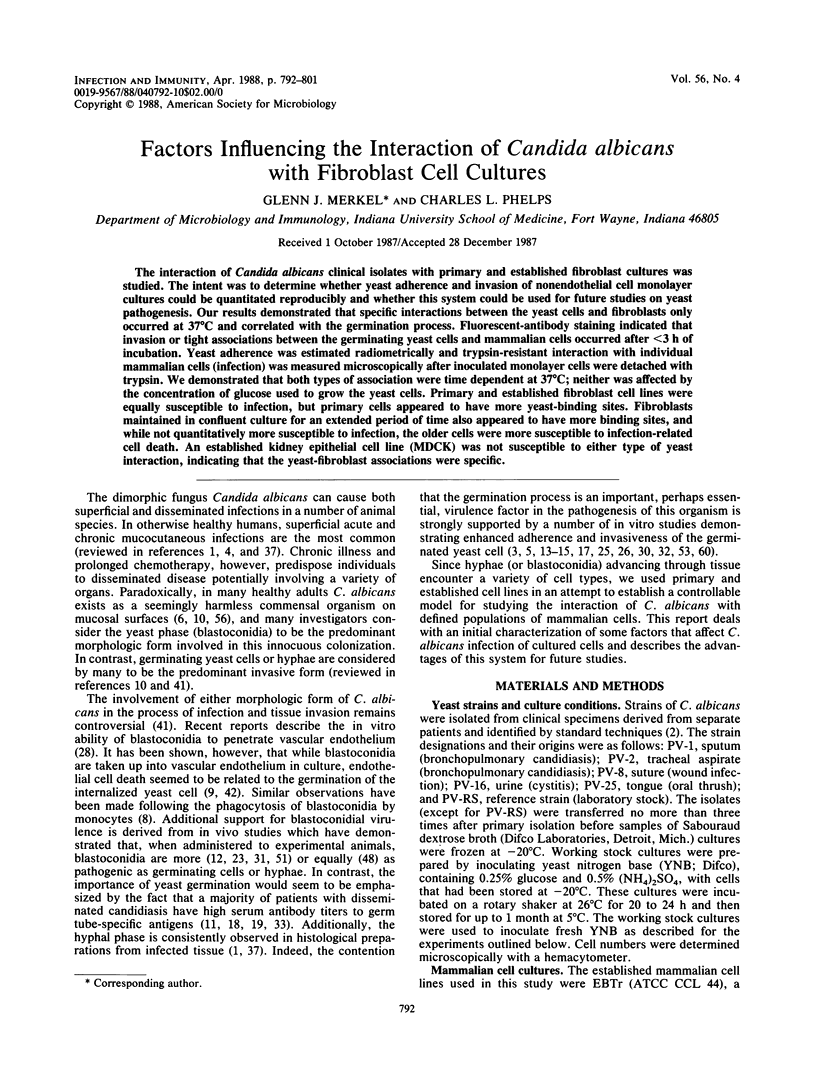
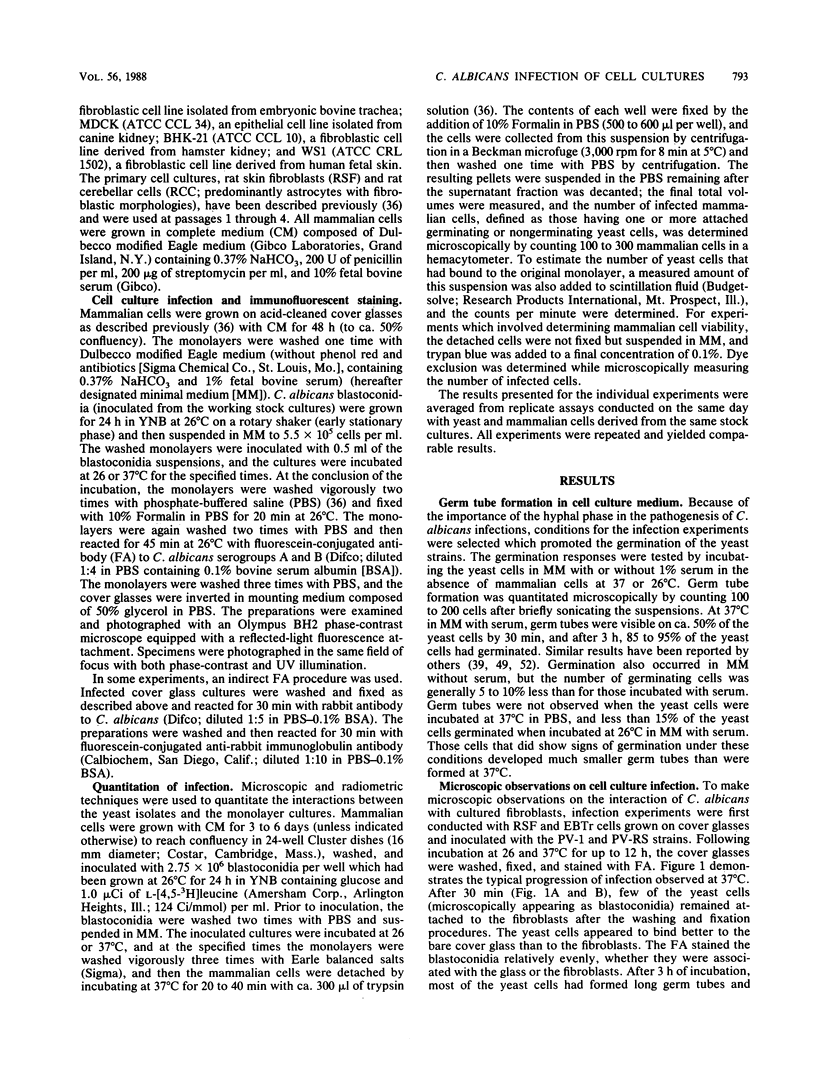
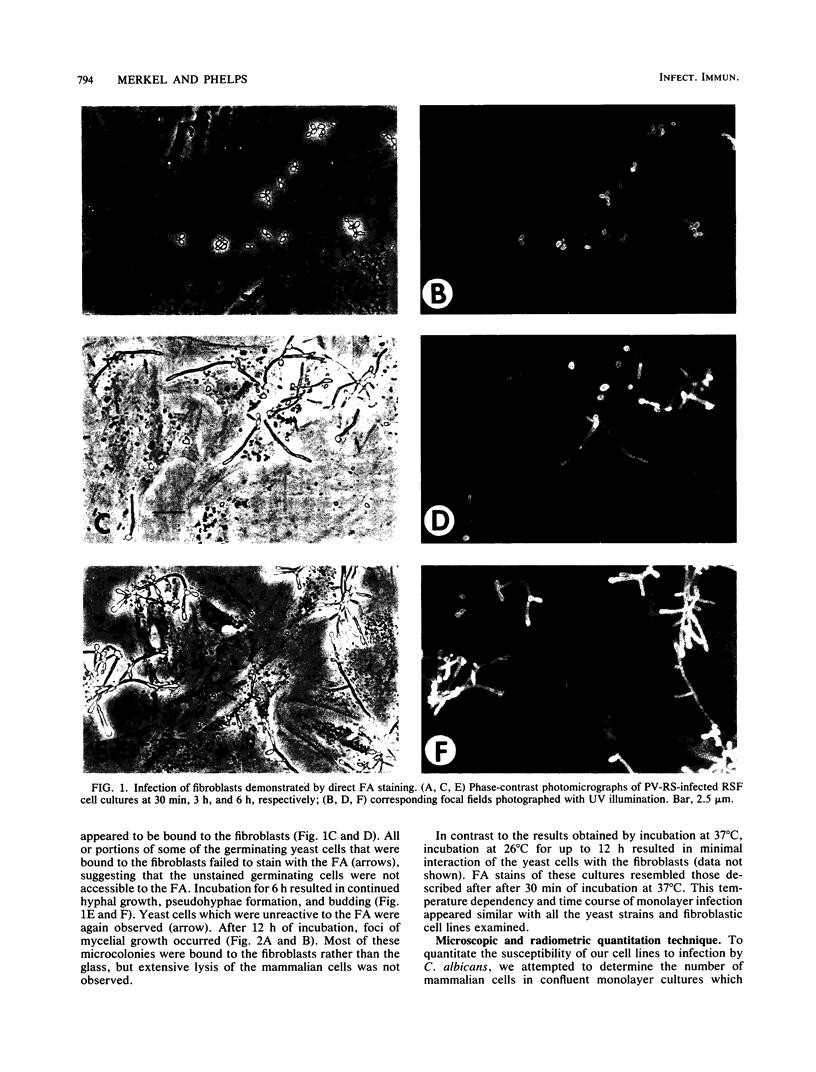
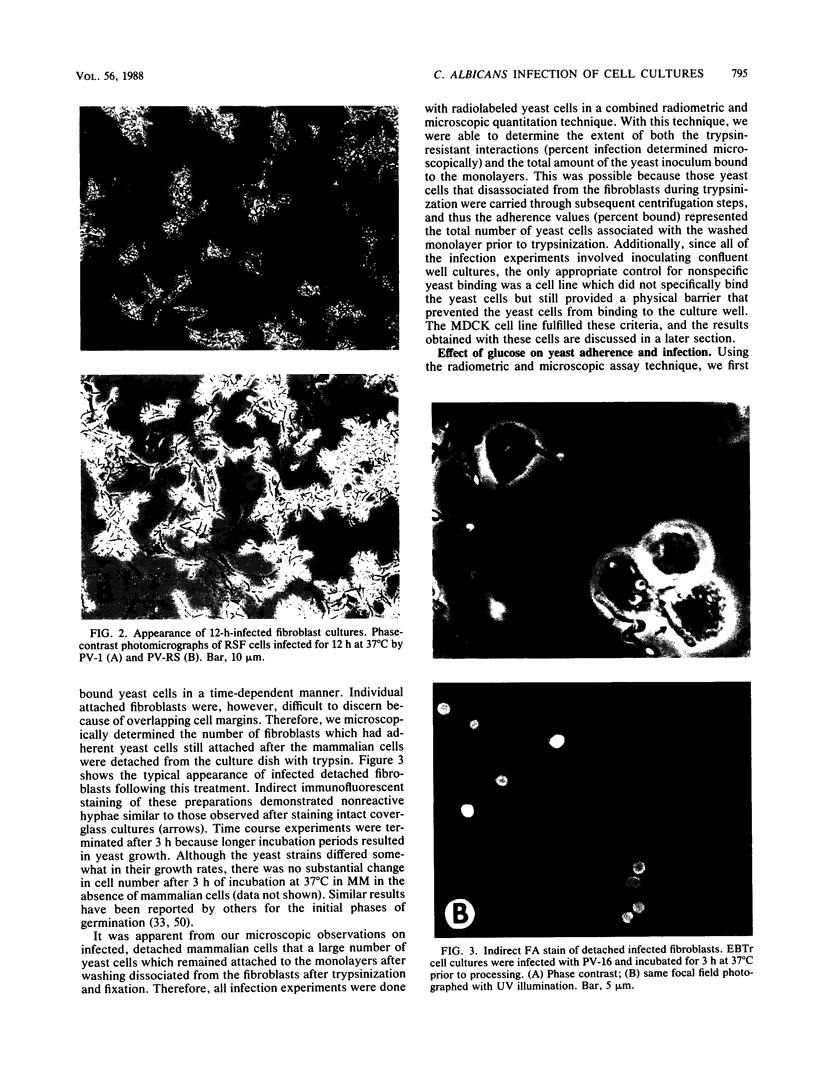
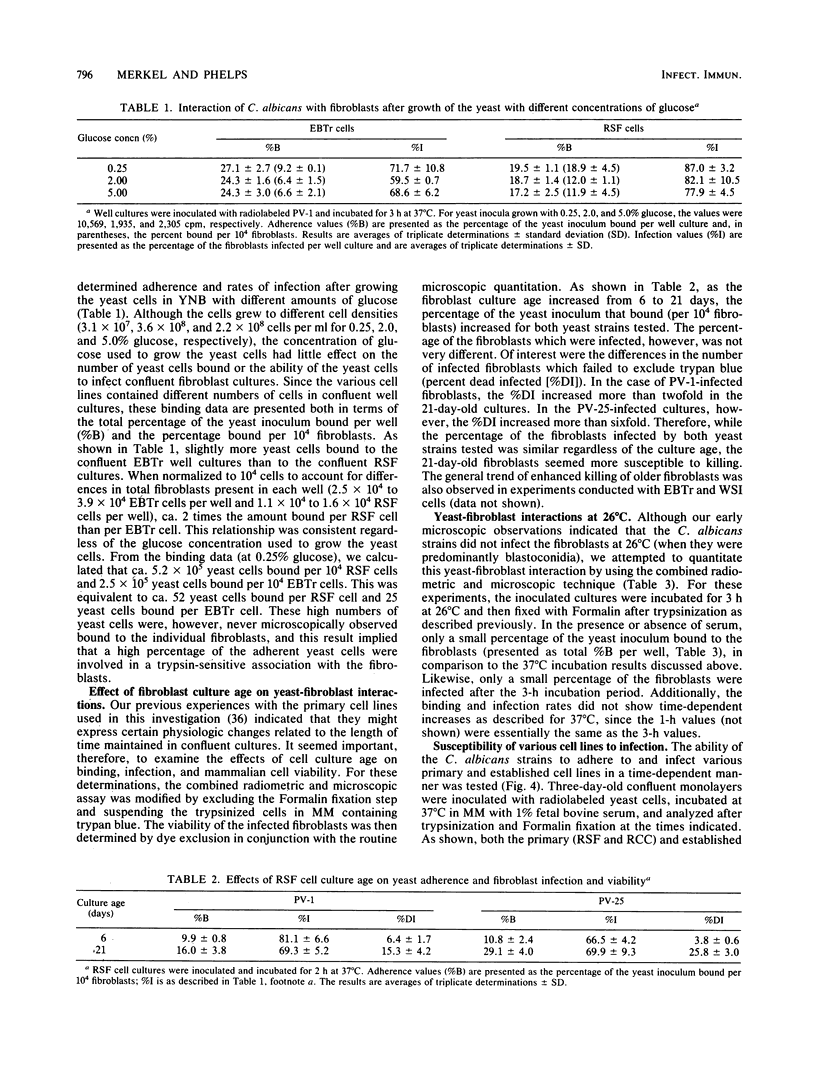
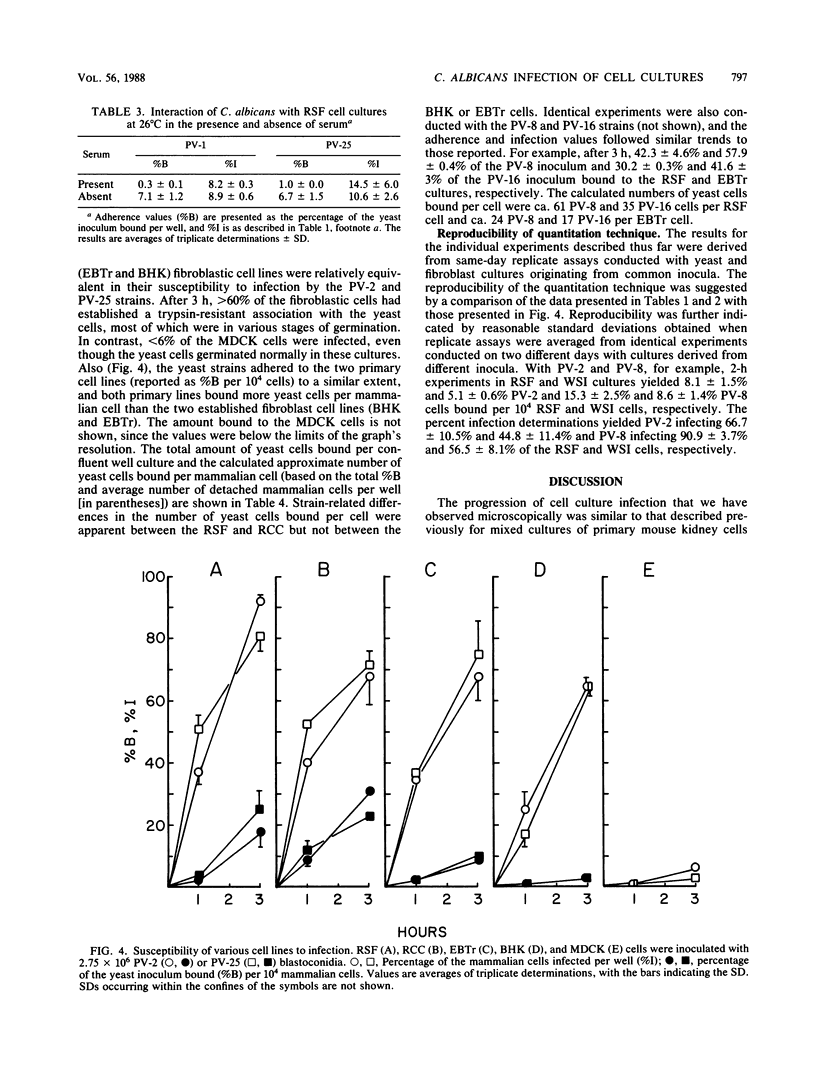
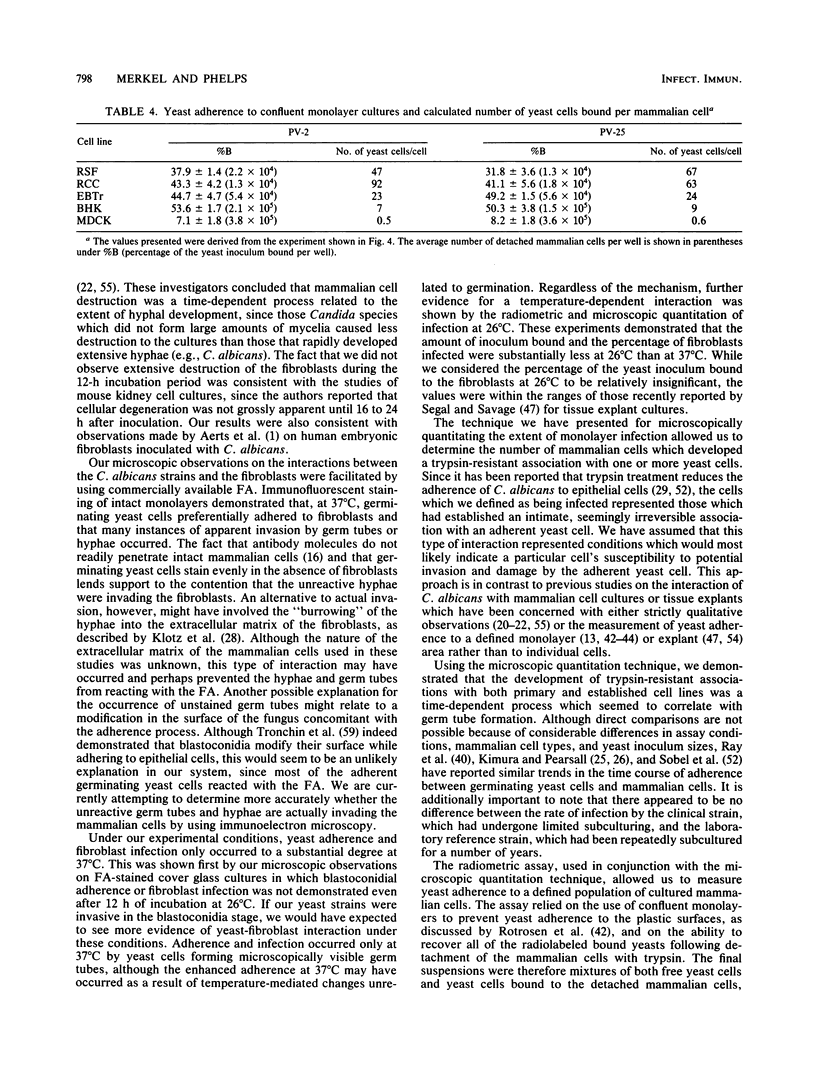
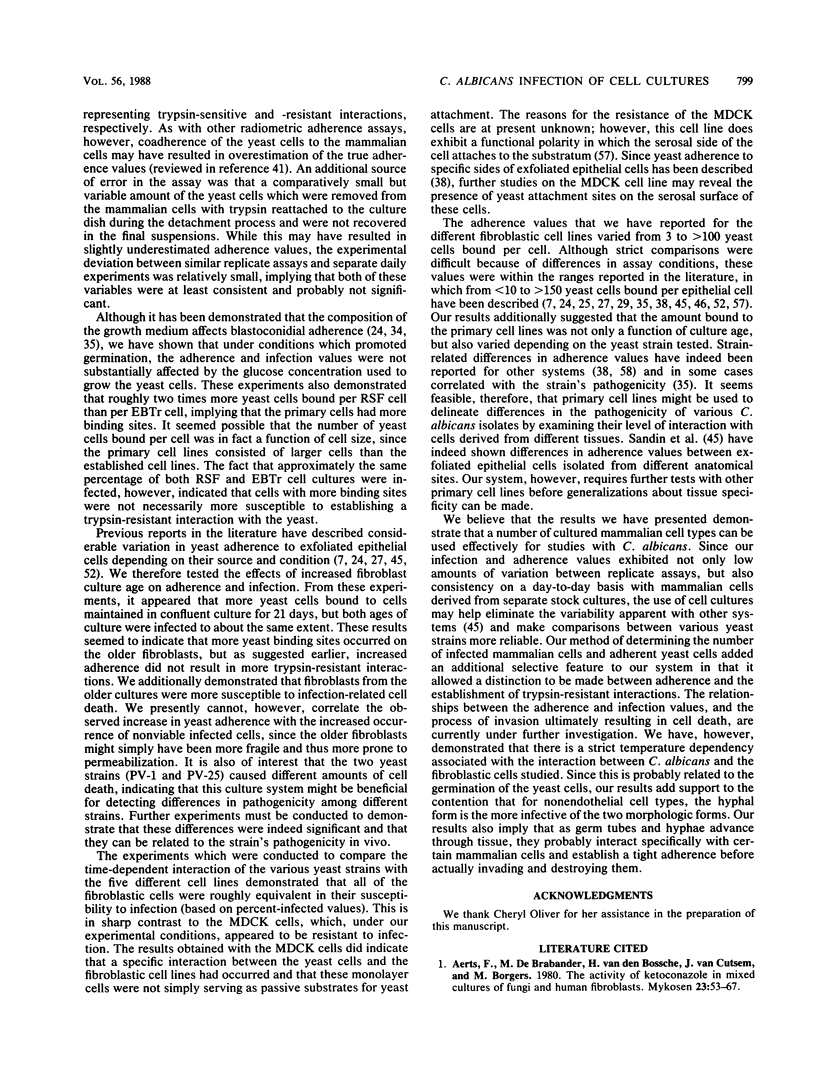
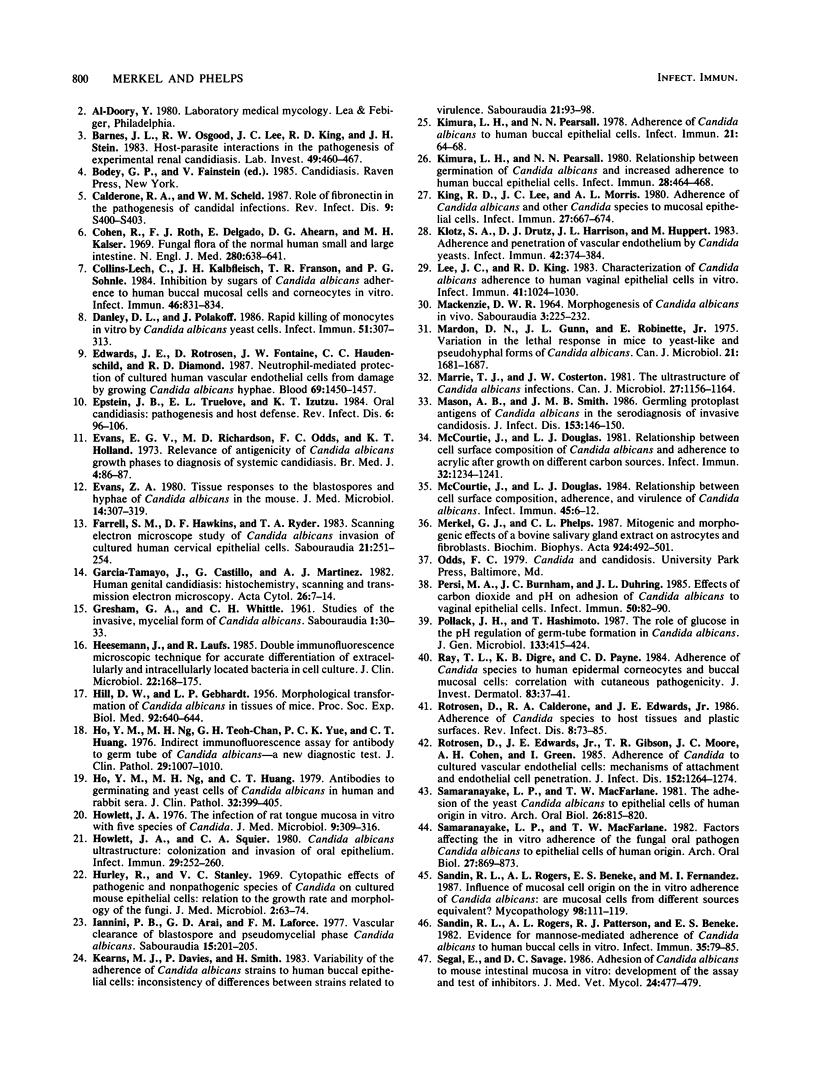
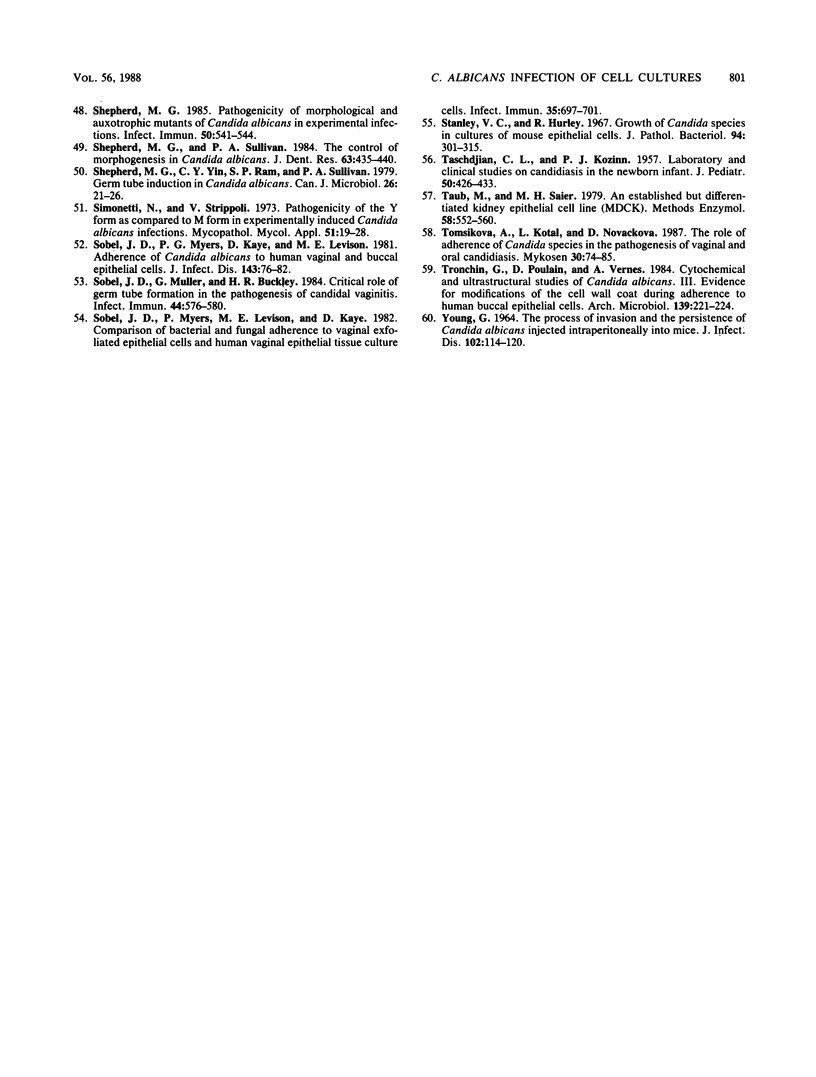
Images in this article
Selected References
These references are in PubMed. This may not be the complete list of references from this article.
- Aerts F., De Brabander M., van den Bossche H., van Cutsem J., Borgers M. The activity of ketoconazole in mixed cultures of fungi and human fibroblasts. Mykosen. 1980 Feb;23(2):53–67. doi: 10.1111/j.1439-0507.1980.tb02581.x. [DOI] [PubMed] [Google Scholar]
- Barnes J. L., Osgood R. W., Lee J. C., King R. D., Stein J. H. Host-parasite interactions in the pathogenesis of experimental renal candidiasis. Lab Invest. 1983 Oct;49(4):460–467. [PubMed] [Google Scholar]
- Calderone R. A., Scheld W. M. Role of fibronectin in the pathogenesis of candidal infections. Rev Infect Dis. 1987 Jul-Aug;9 (Suppl 4):S400–S403. doi: 10.1093/clinids/9.supplement_4.s400. [DOI] [PubMed] [Google Scholar]
- Cohen R., Roth F. J., Delgado E., Ahearn D. G., Kalser M. H. Fungal flora of the normal human small and large intestine. N Engl J Med. 1969 Mar 20;280(12):638–641. doi: 10.1056/NEJM196903202801204. [DOI] [PubMed] [Google Scholar]
- Collins-Lech C., Kalbfleisch J. H., Franson T. R., Sohnle P. G. Inhibition by sugars of Candida albicans adherence to human buccal mucosal cells and corneocytes in vitro. Infect Immun. 1984 Dec;46(3):831–834. doi: 10.1128/iai.46.3.831-834.1984. [DOI] [PMC free article] [PubMed] [Google Scholar]
- Danley D. L., Polakoff J. Rapid killing of monocytes in vitro by Candida albicans yeast cells. Infect Immun. 1986 Jan;51(1):307–313. doi: 10.1128/iai.51.1.307-313.1986. [DOI] [PMC free article] [PubMed] [Google Scholar]
- Edwards J. E., Jr, Rotrosen D., Fontaine J. W., Haudenschild C. C., Diamond R. D. Neutrophil-mediated protection of cultured human vascular endothelial cells from damage by growing Candida albicans hyphae. Blood. 1987 May;69(5):1450–1457. [PubMed] [Google Scholar]
- Epstein J. B., Truelove E. L., Izutzu K. T. Oral candidiasis: pathogenesis and host defense. Rev Infect Dis. 1984 Jan-Feb;6(1):96–106. doi: 10.1093/clinids/6.1.96. [DOI] [PubMed] [Google Scholar]
- Evans E. G., Richardson M. D., Odds F. C., Holland K. T. Relevance of antigenicity of Candida albicans growth phases to diagnosis of systemic candidiasis. Br Med J. 1973 Oct 13;4(5884):86–87. doi: 10.1136/bmj.4.5884.86. [DOI] [PMC free article] [PubMed] [Google Scholar]
- Evans Z. A. Tissue responses to the blastospores and hyphae of Candida albicans in the mouse. J Med Microbiol. 1981 Aug;14(3):307–319. doi: 10.1099/00222615-14-3-307. [DOI] [PubMed] [Google Scholar]
- Farrell S. M., Hawkins D. F., Ryder T. A. Scanning electron microscope study of Candida albicans invasion of cultured human cervical epithelial cells. Sabouraudia. 1983 Sep;21(3):251–254. [PubMed] [Google Scholar]
- GEBHARDT L. P., HILL D. W. Morphological transformation of Candida albicans in tissues of mice. Proc Soc Exp Biol Med. 1956 Jul;92(3):640–644. doi: 10.3181/00379727-92-22570. [DOI] [PubMed] [Google Scholar]
- GRESHAM G. A., WHITTLE C. H. Studies of the invasive, mycelial form of Candida albicans. Sabouraudia. 1961 Jan;1:30–33. doi: 10.1080/00362176285190081. [DOI] [PubMed] [Google Scholar]
- García-Tamayo J., Castillo G., Martínez A. J. Human genital candidiasis: histochemistry, scanning and transmission electron microscopy. Acta Cytol. 1982 Jan-Feb;26(1):7–14. [PubMed] [Google Scholar]
- Heesemann J., Laufs R. Double immunofluorescence microscopic technique for accurate differentiation of extracellularly and intracellularly located bacteria in cell culture. J Clin Microbiol. 1985 Aug;22(2):168–175. doi: 10.1128/jcm.22.2.168-175.1985. [DOI] [PMC free article] [PubMed] [Google Scholar]
- Ho Y. M., Ng M. H., Huang C. T. Antibodies to germinating and yeast cells of Candida albicans in human and rabbit sera. J Clin Pathol. 1979 Apr;32(4):399–405. doi: 10.1136/jcp.32.4.399. [DOI] [PMC free article] [PubMed] [Google Scholar]
- Ho Y. M., Ng M. H., Teoh-Chan C. H., Yue P. C., Huang C. T. Indirect immunofluorescence assay for antibody to germ tube of Candida albicans--a new diagnostic test. J Clin Pathol. 1976 Nov;29(11):1007–1010. doi: 10.1136/jcp.29.11.1007. [DOI] [PMC free article] [PubMed] [Google Scholar]
- Howlett J. A., Squier C. A. Candida albicans ultrastructure: colonization and invasion of oral epithelium. Infect Immun. 1980 Jul;29(1):252–260. doi: 10.1128/iai.29.1.252-260.1980. [DOI] [PMC free article] [PubMed] [Google Scholar]
- Howlett J. A. The infection of rat tongue mucosa in vitro with five species of Candida. J Med Microbiol. 1976 Aug;9(3):309–316. doi: 10.1099/00222615-9-3-309. [DOI] [PubMed] [Google Scholar]
- Hurley R., Stanley V. C. Cytopathic effects of pathogenic and non-pathogenic species of Candida on cultured mouse epithelial cells: relation to the growth rate and morphology of the fungi. J Med Microbiol. 1969 Feb;2(1):63–74. doi: 10.1099/00222615-2-1-63. [DOI] [PubMed] [Google Scholar]
- Iannini P. B., Arai G. D., LaForce F. M. Vascular clearance of blastospore and pseudomycelial phase Candida albicans. Sabouraudia. 1977 Jul;15(2):201–205. [PubMed] [Google Scholar]
- Kearns M. J., Davies P., Smith H. Variability of the adherence of Candida albicans strains to human buccal epithelial cells: inconsistency of differences between strains related to virulence. Sabouraudia. 1983 Jun;21(2):93–98. doi: 10.1080/00362178385380161. [DOI] [PubMed] [Google Scholar]
- Kimura L. H., Pearsall N. N. Adherence of Candida albicans to human buccal epithelial cells. Infect Immun. 1978 Jul;21(1):64–68. doi: 10.1128/iai.21.1.64-68.1978. [DOI] [PMC free article] [PubMed] [Google Scholar]
- Kimura L. H., Pearsall N. N. Relationship between germination of Candida albicans and increased adherence to human buccal epithelial cells. Infect Immun. 1980 May;28(2):464–468. doi: 10.1128/iai.28.2.464-468.1980. [DOI] [PMC free article] [PubMed] [Google Scholar]
- King R. D., Lee J. C., Morris A. L. Adherence of Candida albicans and other Candida species to mucosal epithelial cells. Infect Immun. 1980 Feb;27(2):667–674. doi: 10.1128/iai.27.2.667-674.1980. [DOI] [PMC free article] [PubMed] [Google Scholar]
- Klotz S. A., Drutz D. J., Harrison J. L., Huppert M. Adherence and penetration of vascular endothelium by Candida yeasts. Infect Immun. 1983 Oct;42(1):374–384. doi: 10.1128/iai.42.1.374-384.1983. [DOI] [PMC free article] [PubMed] [Google Scholar]
- Lee J. C., King R. D. Characterization of Candida albicans adherence to human vaginal epithelial cells in vitro. Infect Immun. 1983 Sep;41(3):1024–1030. doi: 10.1128/iai.41.3.1024-1030.1983. [DOI] [PMC free article] [PubMed] [Google Scholar]
- Mackenzie D. W. Morphogenesis of Candida albicans in vivo. Sabouraudia. 1964 Jun;3(3):225–232. [PubMed] [Google Scholar]
- Mardon D. N., Gunn J. L., Robinette E., Jr Variation in the lethal response in mice to yeast-like and pseudohyphal forms of Candida albicans. Can J Microbiol. 1975 Nov;21(11):1681–1687. doi: 10.1139/m75-246. [DOI] [PubMed] [Google Scholar]
- Marrie T. J., Costerton J. W. The ultrastructure of Candida albicans infections. Can J Microbiol. 1981 Nov;27(11):1156–1164. doi: 10.1139/m81-181. [DOI] [PubMed] [Google Scholar]
- Mason A. B., Smith J. M. Germling protoplast antigens of Candida albicans in the serodiagnosis of invasive candidosis. J Infect Dis. 1986 Jan;153(1):146–150. doi: 10.1093/infdis/153.1.146. [DOI] [PubMed] [Google Scholar]
- McCourtie J., Douglas L. J. Relationship between cell surface composition of Candida albicans and adherence to acrylic after growth on different carbon sources. Infect Immun. 1981 Jun;32(3):1234–1241. doi: 10.1128/iai.32.3.1234-1241.1981. [DOI] [PMC free article] [PubMed] [Google Scholar]
- McCourtie J., Douglas L. J. Relationship between cell surface composition, adherence, and virulence of Candida albicans. Infect Immun. 1984 Jul;45(1):6–12. doi: 10.1128/iai.45.1.6-12.1984. [DOI] [PMC free article] [PubMed] [Google Scholar]
- Merkel G. J., Phelps C. L. Mitogenic and morphogenic effects of a bovine salivary gland extract on astrocytes and fibroblasts. Biochim Biophys Acta. 1987 Jun 22;924(3):492–501. doi: 10.1016/0304-4165(87)90165-6. [DOI] [PubMed] [Google Scholar]
- Persi M. A., Burnham J. C., Duhring J. L. Effects of carbon dioxide and pH on adhesion of Candida albicans to vaginal epithelial cells. Infect Immun. 1985 Oct;50(1):82–90. doi: 10.1128/iai.50.1.82-90.1985. [DOI] [PMC free article] [PubMed] [Google Scholar]
- Pollack J. H., Hashimoto T. The role of glucose in the pH regulation of germ-tube formation in Candida albicans. J Gen Microbiol. 1987 Feb;133(2):415–424. doi: 10.1099/00221287-133-2-415. [DOI] [PubMed] [Google Scholar]
- Ray T. L., Digre K. B., Payne C. D. Adherence of Candida species to human epidermal corneocytes and buccal mucosal cells: correlation with cutaneous pathogenicity. J Invest Dermatol. 1984 Jul;83(1):37–41. doi: 10.1111/1523-1747.ep12261661. [DOI] [PubMed] [Google Scholar]
- Rotrosen D., Calderone R. A., Edwards J. E., Jr Adherence of Candida species to host tissues and plastic surfaces. Rev Infect Dis. 1986 Jan-Feb;8(1):73–85. doi: 10.1093/clinids/8.1.73. [DOI] [PubMed] [Google Scholar]
- Rotrosen D., Edwards J. E., Jr, Gibson T. R., Moore J. C., Cohen A. H., Green I. Adherence of Candida to cultured vascular endothelial cells: mechanisms of attachment and endothelial cell penetration. J Infect Dis. 1985 Dec;152(6):1264–1274. doi: 10.1093/infdis/152.6.1264. [DOI] [PubMed] [Google Scholar]
- Samaranayake L. P., MacFarlane T. W. Factors affecting the in-vitro adherence of the fungal oral pathogen Candida albicans to epithelial cells of human origin. Arch Oral Biol. 1982;27(10):869–873. doi: 10.1016/0003-9969(82)90043-7. [DOI] [PubMed] [Google Scholar]
- Samaranayake L. P., MacFarlane T. W. The adhesion of the yeast Candida albicans to epithelial cells of human origin in vitro. Arch Oral Biol. 1981;26(10):815–820. doi: 10.1016/0003-9969(81)90178-3. [DOI] [PubMed] [Google Scholar]
- Sandin R. L., Rogers A. L., Beneke E. S., Fernandez M. I. Influence of mucosal cell origin on the in vitro adherence of Candida albicans: are mucosal cells from different sources equivalent? Mycopathologia. 1987 May;98(2):111–119. doi: 10.1007/BF00437297. [DOI] [PubMed] [Google Scholar]
- Sandin R. L., Rogers A. L., Patterson R. J., Beneke E. S. Evidence for mannose-mediated adherence of Candida albicans to human buccal cells in vitro. Infect Immun. 1982 Jan;35(1):79–85. doi: 10.1128/iai.35.1.79-85.1982. [DOI] [PMC free article] [PubMed] [Google Scholar]
- Segal E., Savage D. C. Adhesion of Candida albicans to mouse intestinal mucosa in vitro: development of the assay and test of inhibitors. J Med Vet Mycol. 1986 Dec;24(6):477–479. [PubMed] [Google Scholar]
- Shepherd M. G. Pathogenicity of morphological and auxotrophic mutants of Candida albicans in experimental infections. Infect Immun. 1985 Nov;50(2):541–544. doi: 10.1128/iai.50.2.541-544.1985. [DOI] [PMC free article] [PubMed] [Google Scholar]
- Shepherd M. G., Sullivan P. A. The control of morphogenesis in Candida albicans. J Dent Res. 1984 Mar;63(3):435–440. doi: 10.1177/00220345840630031501. [DOI] [PubMed] [Google Scholar]
- Shepherd M. G., Yin C. Y., Ram S. P., Sullivan P. A. Germ tube induction in Candida albicans. Can J Microbiol. 1980 Jan;26(1):21–26. doi: 10.1139/m80-004. [DOI] [PubMed] [Google Scholar]
- Simonetti N., Strippoli V. Pathogenicity of the Y form as compared to M form in experimentally induced Candida albicans infections. Mycopathol Mycol Appl. 1973 Sep 28;51(1):19–28. doi: 10.1007/BF02141282. [DOI] [PubMed] [Google Scholar]
- Sobel J. D., Muller G., Buckley H. R. Critical role of germ tube formation in the pathogenesis of candidal vaginitis. Infect Immun. 1984 Jun;44(3):576–580. doi: 10.1128/iai.44.3.576-580.1984. [DOI] [PMC free article] [PubMed] [Google Scholar]
- Sobel J. D., Myers P. G., Kaye D., Levison M. E. Adherence of Candida albicans to human vaginal and buccal epithelial cells. J Infect Dis. 1981 Jan;143(1):76–82. doi: 10.1093/infdis/143.1.76. [DOI] [PubMed] [Google Scholar]
- Sobel J. D., Myers P., Levison M. E., Kaye D. Comparison of bacterial and fungal adherence to vaginal exfoliated epithelial cells and human vaginal epithelial tissue culture cells. Infect Immun. 1982 Feb;35(2):697–701. doi: 10.1128/iai.35.2.697-701.1982. [DOI] [PMC free article] [PubMed] [Google Scholar]
- Stanley V. C., Hurley R. Growth of Candida species in cultures of mouse epithelial cells. J Pathol Bacteriol. 1967 Oct;94(2):301–315. doi: 10.1002/path.1700940207. [DOI] [PubMed] [Google Scholar]
- TASCHDJIAN C. L., KOZINN P. J. Laboratory and clinical studies on candidiasis in the newborn infant. J Pediatr. 1957 Apr;50(4):426–433. doi: 10.1016/s0022-3476(57)80252-2. [DOI] [PubMed] [Google Scholar]
- Taub M., Saier M. H., Jr An established but differentiated kidney epithelial cell line (MDCK). Methods Enzymol. 1979;58:552–560. doi: 10.1016/s0076-6879(79)58170-1. [DOI] [PubMed] [Google Scholar]
- Tomsíková A., Kotál L., Novácková D. Rolle der Adhärenzfähigkeit von Candida-Arten bei der Pathogenese der vaginalen und oralen Candidosen. Mykosen. 1987 Feb;30(2):74–85. [PubMed] [Google Scholar]
- Tronchin G., Poulain D., Vernes A. Cytochemical and ultrastructural studies of Candida albicans. III. Evidence for modifications of the cell wall coat during adherence to human buccal epithelial cells. Arch Microbiol. 1984 Oct;139(2-3):221–224. doi: 10.1007/BF00402004. [DOI] [PubMed] [Google Scholar]
- YOUNG G. The process of invasion and the persistence of Candida albicans injected intraperitoneally into mice. J Infect Dis. 1958 Mar-Apr;102(2):114–120. doi: 10.1093/infdis/102.2.114. [DOI] [PubMed] [Google Scholar]



